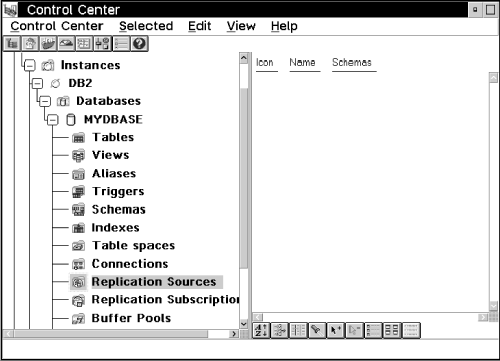

The Control Center is the database administration tool for the DB2 Universal Database and is the tool that you use for replication administration. The Control Center automates many initialization functions, such as creating target tables and control tables when you specify target copy information.
This section briefly explains the main replication tasks that you perform from the Control Center, the objects that you use in the Control Center, the types of target table copies that you can create, auto-registration, and the control tables that are created when you use the Control Center. See Part 3. Administering Your Replication System for more detailed information about Control Center replication tasks. See Administration Getting Started for your platform for more information about the Control Center. See the DB2 DataJoiner V2 documentation for details about heterogeneous replication administration.
You must be a replication administrator to perform the replication administration tasks from the Control Center.
The main Control Center administration tasks for replication are:
You can also specify SQL statements that you want to execute before or after the subscription is executed.
Other tasks include removing replication sources that are no longer sources for copies, cloning replication sources and subscriptions to other servers, and removing replication subscriptions.
You do not use the Control Center to operate the Capture and Apply programs.
You can access your replication source and target definitions through the Control Center. There are three containers that organize the objects that you use to set up and maintain your replication environment:
You work with three GUI objects: Tables, Replication Sources, and Replication Subscriptions, to manage replication sources and targets.
Figure 3 shows the Control Center window.
Figure 3. The Control Center and the Replication Folders. The Control Center and the replication folders provide administration tools for replication. 
IBM Replication offers you many choices for target table structures. Depending on the kind of data you want in your application system, you can choose how changes are copied to the target table. Target tables function as historical or trend information, sources for update-anywhere replication, or simply an identical copy of the source table. The different types of target tables are:
Some target table types are designed to become sources for additional replication. The CCD table and the replica table are almost always used in multiple tier or circular replication scenarios and are automatically defined as replication sources when you define them as part of a replication subscription.
IBM Replication tools use control tables to communicate with each other and to manage replication requests such as defining and managing sources and targets, capturing changes, and replicating changes. These control tables are located at the source, control, and target servers, which are defined in Terminology.
When you use the Control Center to perform replication administration tasks, it creates and maintains the replication control tables used by the Capture and Apply programs. These tables are created and stored at the source, control, and target servers. The workstation where the Control Center is located must be connected to all the databases where source tables exist and the Capture program runs (the source server), all the databases where the target tables will be created and the Apply program usually runs (the target server), and all the databases where the subscription control tables are stored (the control server). The exception is the "occasionally connected," or mobile environment, in which you can create and save as SQL a replication subscription definition, transfer it to another machine, and run it from there.
Most administrators need to customize the control tables for their site requirements or DB2 platforms. To customize the control tables, you must perform some steps before you perform replication requests (that is, before you define sources or subscriptions with the Control Center). For more information on customizing control tables, see Working with Customized Replication Control Tables.